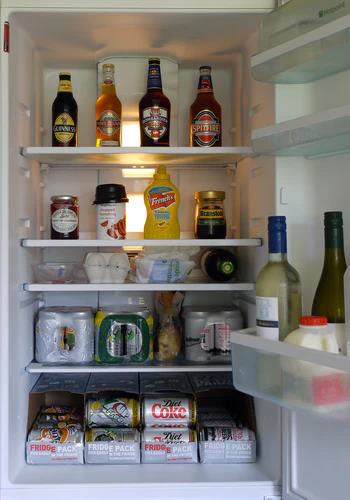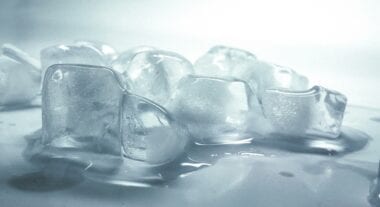If you’re rocking a newly-bought Samsung refrigerator in your household, you’re probably wondering how to properly defrost your cooling appliance. While defrosting could be perplexing, especially if you are not that acquainted with your refrigerator, it is quite simple and will take a few minutes to execute.
And if you’re worried about wasting countless hours reading your user guide and various online tutorials and trying out different buttons on your refrigerator, which could compromise its configuration, we’ve got you covered! We at DaDongNY will teach you all you need to know about defrosting and provide step-by-step instructions on defrosting your Samsung refrigerator.
But, What Exactly Is Refrigerator Defrosting?
When the refrigerator door is often opened, moisture penetrates your refrigerator and accumulates due to the extremely frigid temperatures within the freezer.
If you try to access the freezer compartment, you will immediately notice that it is stuffed to the brim with ice build-up. All our frozen food stored is completely frozen solid, making it difficult to remove from the freezer.
And if you want to get rid of the ice from your freezer, you’ll need help trying to do this even with a sharp tool, which is not advised as it could harm your appliance.
Thanks to Samsung, one of the most trusted refrigerator brands, practically every one of their refrigerator units comes with a defrost button that melts all of the accumulated ice from the freezer and drains all of the water after the process.
Defrosting is the process of eliminating ice from a refrigerator’s freezer compartment.
What Causes Ice To Build Up In Your Refrigerator
Ice accumulates in your refrigerator for a number of different reasons. The majority of these factors are the outcome of your daily routine. What happens to your Samsung refrigerator is heavily influenced by how you use it. Yet, the ice developing in your Samsung refrigerator might be something other than your own doing. Here are some of the most common causes of ice build-up in your refrigerator:
- Hot Air
It is one of the most common sources of frost in every refrigerator. Ice starts to form when the evaporator coils in your refrigerator that create chilly air come into touch with damp or hot air.
As you open your refrigerator to pull out your favorite cold brew on a hot summer day, you expose it to foreign air. Doing this will not allow all the hot air that could cause heavy ice accumulation to enter. Nevertheless, opening your refrigerator multiple times during the day risks creating an unpleasant ice block inside.
Therefore, instead of grabbing something from the fridge once every while, take anything you need to eat throughout the day with you. This will keep the quantity of hot air that could enter your refrigerator.
- Refrigerant
The amount of coolant inside your refrigerator can also influence whether or not ice will accumulate. Having low refrigerant in your refrigerator could lead to poor refrigerant compression inside the compressor. As a result, warm air will be emitted rather than cold air.
However, if you use too much refrigerant, the liquid refrigerant could spill into the refrigerator’s coils, resulting in the development of ice.
- Damaged Components
Ice accumulation may occur when several of your refrigerator’s parts are damaged. The compressor and defrost thermostat are the most important components of a refrigerator that can contribute to the development of ice.
The defrost thermostat regulates the time spent chilling and defrosting your fridge, and If it is defective, your refrigerator can keep on chilling until ice build-up occurs.
If you find obvious signs of ice accumulating in your Samsung refrigerator, this implies that the compressor is possibly broken. To fix this issue, contact the manufacturer to request a replacement.
Additionally, self-defrosting freezers must be cooled for 6 to 12 hours before defrosting. They defrost automatically by triggering the defrost heater while shutting the compressor off.
Defrosting A Samsung Refrigerator: Steps To Take
- Switch Off The Refrigerator
Make sure to switch off your Samsung refrigerator before you begin defrosting it. Keeping the refrigerator on while trying to defrost could result in even more ice accumulation.
You could also end up breaking your refrigerator. Also, keep in mind that your refrigerator is electrical equipment, and if things go out of control, the chances of electrocution can arise.
- Remove All The Foods
Remove everything from your refrigerator once you’ve turned it off. If you don’t have a lot of food in your refrigerator, you can eat it before you start defrosting it. If it will take a while to consume everything, get a portable cooler loaded with ice and place all the food here. Unloading your refrigerator makes more room for the defrosting cycle.
- Take Out The Shelves
While defrosting your refrigerator, it is an excellent time to clean it. However, your refrigerator’s shelves could be jammed because of the thick ice accumulation, especially on the edges of the fridge shelves.
As a result, they are difficult to remove. Let them sit for a while in this scenario as you continue the defrosting process. By then, you’d be able to remove the ice surrounding them shortly.
- Open The Doors
Opening the door is one of the easiest ways to defrost your Samsung refrigerator. And since the refrigerator is switched off, opening the door lets hot air through the appliance. This hot air melts any ice accumulation from the walls.
While this might be daunting, especially if the ice in the refrigerator is thick, It could take a day or more to complete.
Here are some more things you may do to speed up the defrosting process:
- Put a bowl filled with boiling water on every shelf of your refrigerator. The steam would cause the ice on the walls to melt.
- Scrape the ice from the refrigerator walls with an ice scraper, a wooden spoon, or a plastic spatula.
- Melt the ice accumulation on the refrigerator quicker by using a hair dryer. To prevent your dryer from overheating, focus on one area at a time.
- Soak the towel in hot water, then in alcohol, and place it on the edges of ice accumulated in your refrigerator.
- Clean Out The Refrigerator
While you’re doing it, make sure to thoroughly clean the parts. Once you’ve removed the shelves, clean them with soap and water and dry them with clean washcloths. Once you’ve finished defrosting, use some cleaning solutions to wipe the interior of your refrigerator.
- Organize The Refrigerator
Once your refrigerator is done defrosting and completely dry, reassemble the parts. Return the foods you took from the shelves and drawers to their places.
You can switch it on to chill it before putting your products in it. However, this procedure brings hot air into your refrigerator. As a result, frost accumulation could occur again. Therefore, put everything back in the fridge, shut all the doors and turn it on.
What To Do And What Not To Do To Defrost Your Samsung Refrigerator
While defrosting your Samsung refrigerator, there are various things you should and should not do. Here, we’ve listed a few of them:
| Dos |
| Keep your tools ready since you don’t want to rush when it’s finally time to defrost your refrigerator. Prepare your bowls of water and other items to swiftly defrost your Samsung refrigerator. |
| You can multitask when necessary. When the ice melts, you may rummage through the portable cooler that contains the food items from your refrigerator. |
| It is critical to start cleaning up the refrigerator following the defrosting process, especially if it has been a long time since it has been cleaned. During the waiting time, you can clean the refrigerator’s glass shelves, doors and sides and clean any other pieces you removed before defrosting. |
| Don’ts |
| Do not leave the door open even when using a bowl of scorching hot water to defrost your refrigerator. You’ll need as much hot air as possible. And thereby, shutting your door only permits cold air to circulate in your refrigerator. As a result, you may be unable to defrost your refrigerator for an extended period, and it may become damaged. |
| Some consumers only defrost or clean their refrigerators for a while. Even if you try to keep it clean, refrigerators will accumulate frost over time. Waiting to defrost your refrigerator until the door can no longer be closed is not a good idea. If you wait too long, it will take many days to defrost your refrigerator successfully. |
| Some individuals will defrost their refrigerator with anything, including sharp objects. They probably take up metal blades and other sharp items desperately to remove the obstinate ice from their refrigerator walls. Do not use sharp objects, which could damage the refrigerator wall and the coils. |
Force Defrosting Your Samsung Refrigerator
There are several Samsung refrigerators that include Force Defrost (Fd) mode, and because the configuration of the Force Defrost mode varies based on your model, it might not be easy to keep track of them all.
Below are the button configurations for several Samsung refrigerator models, including how long to hold each one:
| Model | Configuration | Duration |
| Samsung Rf263 | Energy Saver + Fridge | 8 seconds |
| Samsung Rf24fsedbsr | Fridge + Power Save | 8 seconds |
| Samsung Rf267 | Fridge + Lightning (then press the Lightning button again for 4x) | 8 seconds |
| Samsung Srf680cdls | Fridge + Energy Saver | 12 seconds |
| Samsung Rf23j9011sr | Cool Select + Freezer (press any of these 2 buttons 4x until Fd mode appears.) | 8 seconds |
| Samsung Rf263beaesr | Energy Saver button (left side) + Fridge button (right side) | 8 seconds |
| Samsung Rf23m8070sr | Freezer + Control Lock (then Press Control Lock 4x) | 12 seconds |
| Samsung Rf28 | Energy Saver + Power Freeze (then press Power Cool 4x) | 4 seconds |
| Other Variants With An Integrated Controller | Fridge + Flex Zone (then Press Flex Zone 4x) | 10 seconds |
Why Isn’t My Samsung Refrigerator Defrosting
There are several reasons why your Samsung refrigerator isn’t defrosting, which we’ll go over below:
- The Main Control Board Is Not Working Properly
The main control board on your refrigerator manages how much electricity is distributed to the equipment. If the main control board malfunctions, no electricity is going to be sent to the defrost system.
When this happens, you will see ice accumulation in your refrigerator. Most of the time, this isn’t an issue. As a result, before purchasing a replacement part, you should verify that all other components are in working order and not causing the issue.
- Heater And Defrost Timer Are Both Malfunctioning
The defrost timer operates the defrost heater at regular intervals during the day. When the timer fails, the defrost heater will not operate as it should.
The defrost heater melts the ice on the evaporator coil. If the defrost heater fails, ice will build on the evaporator coil and the walls of your appliance.
- Defrost Control Board Has Been Damaged
It would be best to investigate the defrost control board when you’ve verified that the defrost heater and timer are running smoothly. If the defrost control board is malfunctioning, your refrigerator will not enter the defrost cycle.
- The Defrost Thermostat Is Defective
Your Samsung refrigerator’s defrost thermostat is in charge of keeping track of the temperatures of the evaporator coils. When the temperature of the evaporator coil starts falling below a certain threshold, the defrost thermostat connections close. The defrost timer is then triggered, supplying electricity to the defrost heater. The defrost heater then melts the ice on the evaporator coil.
If your thermostat is faulty, the thermostat contacts will not shut, and the defrost heater will not melt the accumulated ice on the evaporator coil.
FAQs
- What Is The Purpose Of Defrosting Your Samsung Refrigerator?
Defrosting is necessary when the freezer compartment in your refrigerator becomes frozen solid and cannot operate properly. A clogged pipe, a defective defrost heater and timer, or grimy condenser coils are a few of the most common causes. Before putting your refrigerator through a defrost cycle, assess and deal with the root problem first.
- How Frequently Should One Defrost?
It all depends on how you use your fridge on a daily basis as well as how cool it is kept. If you are in a hot region or use your refrigerator frequently, you’ll have to defrost it once a year. In contrast, if you live in a colder location or don’t use your refrigerator as frequently, you may probably get away with defrosting it at least twice every year.
There are a few indications that it’s necessary to defrost your refrigerator, regardless of whether it’s been less than six months. If you see ice on the rear wall of your fridge, frost on your food, or water pool on the shelves, it’s time to get rid of it.
- Is It Possible To Defrost A Samsung Refrigerator Without Turning It Off?
Yes, you can defrost your Samsung refrigerator’s freezer without shutting it off. Samsung has added a dedicated defrost button just on the dial knob of your equipment’s temperature control to effortlessly remove extra ice built from your freezer.
By simply pressing the defrost button, your freezer goes into defrost mode, where it will dissolve the ice deposit for roughly two to three hours before flushing the water out.
- Does The Samsung Refrigerator Defrost Itself?
Samsung has released a number of frost-free refrigerators throughout the years. These refrigerators do not require manual defrosting. Samsung has included a small device inside the appliance that melts the accumulated ice. This process is performed without interrupting your refrigerator’s cooling cycle.
Despite that, several Samsung refrigerators do not defrost automatically. It would help if you manually defrosted your equipment. You need to manually press the defrost button in order to melt all of the ice that has developed in your freezer within two to three hours.
Bottomline
At least once a year, your Samsung refrigerator must be defrosted, especially if you don’t use it regularly. Defrosting and cleaning your refrigerator regularly to maintain it in good operating condition. The procedure is simple, yet entirely removing the ice can take many hours. With the information we provided above, you can defrost your fridge without breaking a sweat.
If you have a self-defrosting Samsung refrigerator, on the other hand, defective parts could prohibit the ice from melting as it should. When this happens, you will need to manually defrost your appliance with the help of the step-by-step instructions outlined above. Then, call for a professional to repair the underlying issue with the self-defrosting feature in your refrigerator.
To learn more about refrigerators and how this valuable piece of equipment chills the food and beverages inside, check out the post here.
Articles You May Be Interested In
- A Cooler Choice: Whirlpool v.s GE Refrigerators (Full Guide)
- Refrigerator Check: LG v.s Samsung Refrigerators (Full Guide)
- Cool Tech Showdown: Frigidaire v.s Whirlpool Refrigerators (Full Guide)
- Fridge Favorites: Bosch v.s LG Refrigerators (Full Guide)
- Cooling Conundrum: Whirlpool v.s Samsung Refrigerators (Full Guide)
- Tale Of The Tape: Maytag v.s Whirlpool Refrigerators (Full Guide)
- Fridges in Focus: Thermador v.s Sub-Zero Refrigerators (Full Guide)
- Fridge Frenzy: Sub-Zero v.s Viking Refrigerators (Full Guide)
- The Big Chill: Whirlpool v.s KitchenAid Refrigerators (Full Guide)
- Refrigerator Bout: Whirlpool v.s LG Refrigerators (Full Guide)









